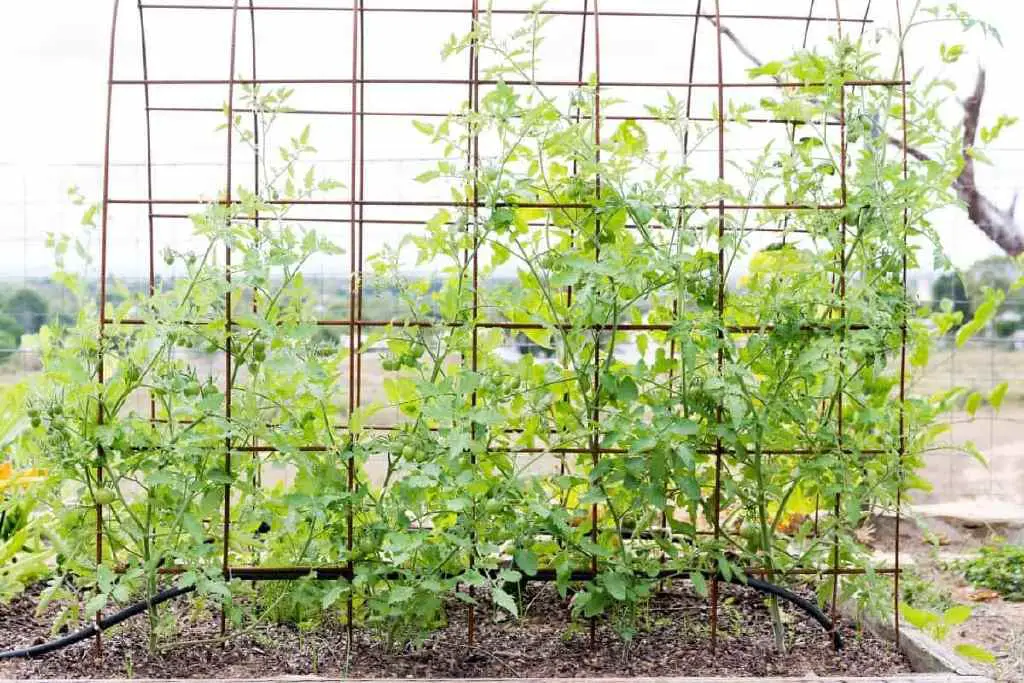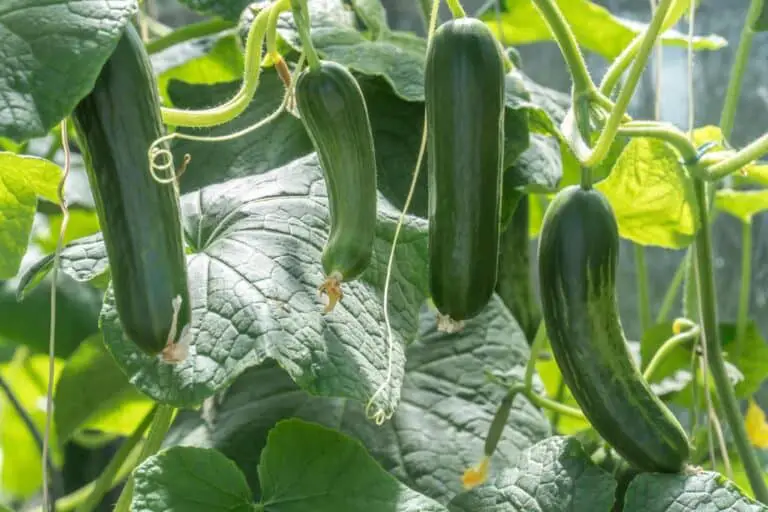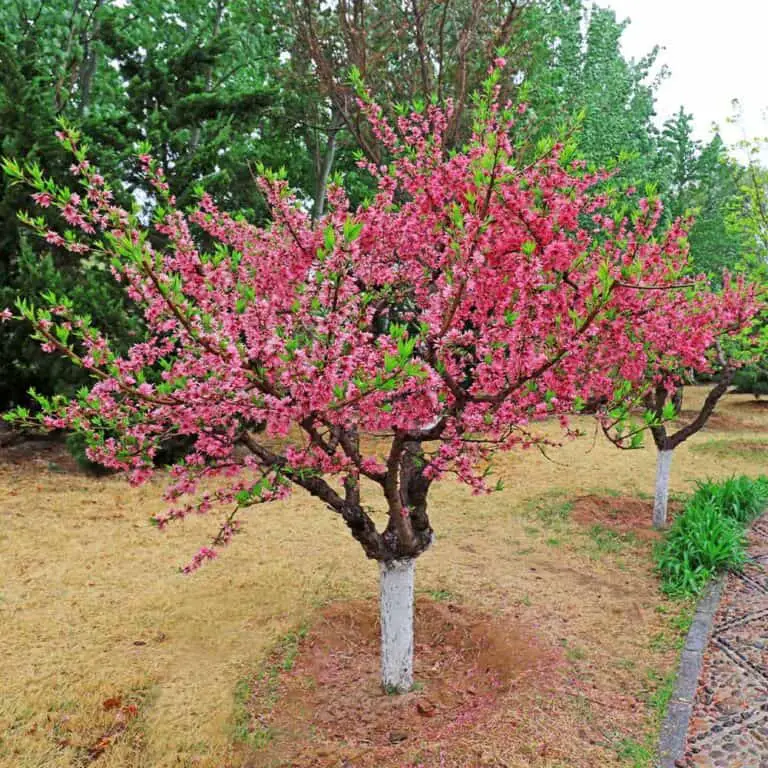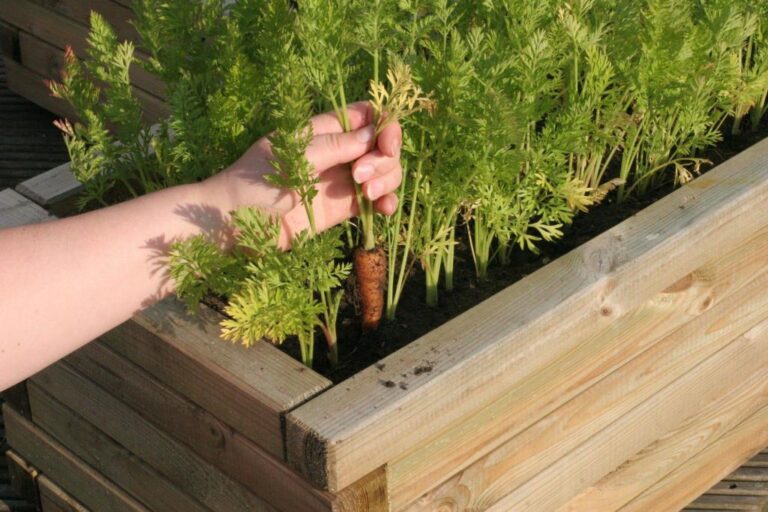Tomato Plants Trellis Support: Why It’s Needed, Advantages & Disadvantages

Tomatoes are a very popular vegetable to grow in gardens, and for good reason. They produce a lot of fruit and are easy to grow.
Tomato plants grow for an indefinite amount of time, which means they will keep growing and making fruit all through the growing season. They are climbing plants and need support to grow properly. Left unchecked, these vines can quickly become unmanageable.
So, why do tomato plants need trellis support? A trellis gives the plant the structure it needs to grow vertically, which allows the plant to produce more fruit. Tomato plants need trellis support to stay healthy and produce a good crop.
A trellis is simply a frame that supports the plant as it grows. A good tomato trellis is made of strong material that will not break under the weight of the plant and its fruit. It should also be tall enough so that the plant has plenty of room to grow.
Plant Trellis Support
A plant trellis is a structure that provides support for climbing plants. Trellises can be made from a variety of materials, such as wood, metal, or plastic, and can be used for both decorative and functional purposes. They come in many different designs and sizes, from small, single-plant supports to large, freestanding structures for growing multiple plants.
One of the main benefits of using a plant trellis is that it allows gardeners to grow climbing plants in a more compact space. By training the plants to climb up the trellis, gardeners can save valuable ground space and make better use of vertical space. This is especially useful for small gardens or indoor spaces where space is limited.
Trellises can also be used to make a garden or other outdoor space look better. Many trellises are designed with intricate patterns and shapes that can add visual interest to a garden. Some trellises even come in decorative shapes like arches and pergolas, which can be used as focal points in a garden or as entryways.
Trellises are used to support climbing plants, but they can also be used to train plants to grow in a certain way or to make a screen for privacy. This can help block out unwanted views or make an outdoor space feel more private.
Why Tomatoes Plant Need Trellis Support

Tomatoes are a popular garden vegetable because they taste great and can be used in many different ways in the kitchen. But if you want your tomato plants to be healthy and fruitful, it’s important to give them the right trellis support.
One of the main reasons why tomatoes need a trellis is because of the way they grow. Tomato plants are indeterminate, which means they keep growing and making fruit all summer long. As the plant grows taller, the stem becomes weaker and can bend or even break under the weight of the fruit. Trellising gives the plant the support it needs to stay upright and protects the stem from damage.
Another reason why tomatoes need trellis support is the weight of the fruit. Tomatoes can be quite heavy, especially when they are fully ripe. If left unsupported, the branches of the plant can break or bend under the weight of the fruit, causing damage to both the fruit and the plant. Trellising provides a way to support the fruit and keep it off the ground, which can help prevent rot and disease.
Finally, trellising can also help prevent disease and pest problems. By keeping the fruit off the ground, trellising reduces the risk of fungal and bacterial diseases that can be caused by soil-borne pathogens. Also, trellising can make it harder for pests like tomato hornworms, aphids, and whiteflies to get to the plant’s fruit and hurt it.
Determinate vs. Indeterminate Tomatoes: Why Is It Important?
Tomatoes are classified as determinate or indeterminate based on their growth habit. Determinate tomatoes grow until they reach a certain size, and then they stop growing. On the other hand, indeterminate tomatoes keep growing and making fruit all through the season.
Both types of tomatoes have their own advantages and disadvantages.
Most determinate tomato varieties are smaller than indeterminate ones, but they’re also easier to care for. These plants do not need to be staked or pruned, and they can be grown in smaller spaces. The downside is that determinate tomatoes ripen all at once, so you may end up with more fruit than you can use at one time.
Indeterminate tomatoes, on the other hand, can grow quite large and require more space. The tomato also need to be staked or supported in some way to keep them from falling over.
Is It OK Not to Trellis Tomato Plants?
It’s a common question among tomato growers: is it really necessary to trellis tomato plants? After all, they are vigorous plants that can grow quite large on their own.
The answer is that it depends on the variety of tomato you’re growing and your personal growing preferences.
If you’re growing a determinate type, you don’t need a trellis because the plant will stop growing once it gets to a certain height. But indeterminate varieties will keep growing and making fruit all season, so you should use a trellis to keep the plant in check.
Trellising tomato plants also helps to keep the fruit off the ground. When tomato fruit is in contact with the ground, it can be exposed to rot and pests. Trellising tomato plants allows the fruit to grow off the ground, reducing the risk of rot and pest damage.
WARNING![]()
Not trellising tomato plants can also make it difficult to manage pests and diseases. Without support, the plants can become overcrowded and this can make it harder to spot and address issues as they arise.
What Tomatoes Don’t Need Trellis Support?
Tomatoes are one of the most commonly grown vegetables in home gardens, and they don’t need trellis support. Tomatoes are self-supporting plants, meaning they don’t need any extra support to grow.
The vines will grow up and around the plant, providing support for the fruit as it grows. Trellis systems can actually do more harm than good for tomatoes. The extra weight of the fruit can cause the vines to break or snap off, leading to lost fruits and a smaller harvest.
Using Tomato Trellis Support the Right Way
Using a tomato trellis the right way can greatly enhance the growth and yields of tomato plants. Here are some tips for using a tomato trellis effectively:
- First, it is important to choose the right type of trellis support for your tomato plants. There are different types of trellises available, such as stake-and-weave, cage, and string trellis. Each type has its own advantages and disadvantages, so it is important to choose the one that best suits your needs. For example, stake-and-weave trellis is best for small gardens, while tomato cage support and trellis is ideal for large gardens.
- Install the trellis support correctly. The trellis should be securely anchored in the ground, and the plants should be tied to the trellis with soft, flexible ties such as twine or cloth strips. It’s essential to ensure that the ties are not too tight, as this can damage the plants.
- Make sure that your trellis is tall enough to accommodate the growth of your plants. Tomato plants can grow quite tall, so you’ll need a trellis that’s at least six feet tall.
- Put the trellis in an area that gets plenty of sunlight. Tomato plants need at least six hours of direct sunlight each day in order to thrive.
- Once the trellis is in place, it is important to train the tomato plants to climb the trellis. This can be done by gently guiding the main stem of the plant to the trellis and tying it to the structure. It’s important to continue to tie the plants to the trellis as they grow, to keep them upright and encourage them to climb.
- Keep the area around the trellis clean and free of debris. This can help to prevent fungal diseases, and it also makes it easier to spot any pests or diseases that may arise.
- Finally, it’s essential to monitor the growth of the plants and make adjustments as needed. This includes removing any dead or diseased branches, cutting back any branches that are crowding the plants, and tying the plants to the trellis as they grow.
Advantages of Tomato Plants’ Trellising Support
Tomato plants that are trellised have many advantages over those that are not.
- For one, they are much more productive. Trellised tomato plants can produce up to 30% more fruit than untrellised plants.
- Like staking tomato plants, trellising offers upright plants for easy picking.
- Plants may be grown close together.
- Allows for two or three main stems to be grown.
- Fruits ripen a bit earlier than those grown as free running.
- Additionally, trellising keeps the fruit off of the ground where it is more likely to rot. This also reduces the risk of disease and pests.
All of these factors make trellising an essential part of tomato production.
Disadvantages of Tomato Plants’ Trellising Support
- Trellising can be hard work, sometimes comparable to staking tomatoes, especially for large numbers of plants.
- Often plants will require training along the wires or string and may require additional bracing.
- When plants are growing vigorously they may require maintenance twice a week or more to keep them trained to the trellis.
- One of the biggest disadvantages of trelling tomato plants is that it can be difficult to keep the stems straight. If the stems are not perfectly straight, the plant will not produce as many tomatoes.
- Another downside is that if the plant gets too tangled, it can start to choke itself and eventually die.
Overall, trellising tomato plants takes a lot of time and effort. However, if done correctly, it can result in a bountiful harvest of delicious tomatoes.
The Different Types of Tomatoes Trellis Supports
There are different kinds of trellises that can be used to grow tomatoes, and each has its own pros and cons. Here are some of the most common types of tomato trellis supports:
- Stake-and-weave trellis: This is a simple and inexpensive option for supporting tomato plants. It involves driving a stake into the ground next to each plant, and then weaving twine or string between the stakes to create a support structure for the plants to climb. This type of trellis is best suited for small gardens or for growing just a few tomato plants.
- Cage trellis: This type of trellis involves using a wire or plastic cage to support the tomato plants. Cages can be purchased or made from wire fencing. They are easy to use and provide a lot of support for the plants, but can take up a lot of space in the garden.
- String trellis: A string trellis is similar to a stake-and-weave trellis, but instead of weaving twine between stakes, strings are stretched between two anchor points and the plants are trained to climb up the strings. This type of trellis is more space-efficient than a stake-and-weave trellis and can be used in large gardens or even commercial farms.
- T-bar trellis: T-bar trellis uses a T-shape structure which can be made out of metal, plastic or wood. The plants are trained to climb up the vertical bars of the T-shape. This type of trellis is more stable than the other types and can support heavy fruits, but it’s also more expensive and harder to install.
- A-frame trellis: A-frame trellis is a freestanding structure that forms an A-shape and can be made out of metal, plastic, or wood. It’s easy to install and provides a lot of support for the plants, but it can also take up a lot of space in the garden.
Conclusion
In conclusion, trellising tomato plants is an important step in growing healthy and productive tomato plants. It provides support for the plants, improves air circulation, keeps the fruit off the ground, and makes it easier to manage pests and diseases.
The different types of trellis supports available, such as stake-and-weave, cage, and string trellis, each have their own advantages and disadvantages, so it’s essential to choose the one that best suits your needs.
While using a trellis support has many benefits, it’s also important to consider the space you have available and the number of plants you want to grow. With proper care and attention, a tomato trellis support can be a valuable tool for growing strong and healthy tomato plants.







